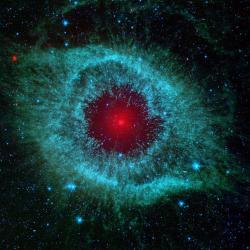 The latest photograph taken by the Spitzer Space Telescope shows a bizarre false colour view of the Helix Nebula. Located around 700 light years from Earth, in the constellation of Aquarius, this beautiful nebula used to be a star similar to our own Sun. As it died, it sloughed off its outer layers, creating the view we see today.
The latest photograph taken by the Spitzer Space Telescope shows a bizarre false colour view of the Helix Nebula. Located around 700 light years from Earth, in the constellation of Aquarius, this beautiful nebula used to be a star similar to our own Sun. As it died, it sloughed off its outer layers, creating the view we see today.
Continue reading “Comets Colliding Inside the Helix Nebula”
Distant Quasars Surrounded by Dark Matter Halos
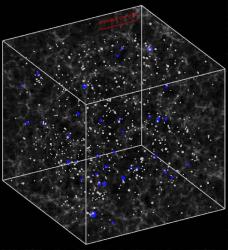 Astronomers have taken 4,000 of the brightest quasars and figured out just how much dark matter surrounds them. As we’re starting to learn, wherever there’s matter, there’s 10x as much dark matter. These quasars back that theory up.
Astronomers have taken 4,000 of the brightest quasars and figured out just how much dark matter surrounds them. As we’re starting to learn, wherever there’s matter, there’s 10x as much dark matter. These quasars back that theory up.
Continue reading “Distant Quasars Surrounded by Dark Matter Halos”
Distant Cluster of Galaxies Viewed by Hubble
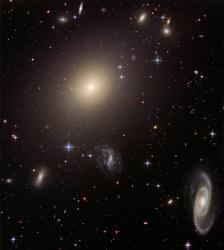 This beautiful picture is of a distant collection of galaxies called the Abell S0740 galaxy cluster, captured by the Hubble Space Telescope. It’s located more than 450 million light years away in the constellation Centaurus.
This beautiful picture is of a distant collection of galaxies called the Abell S0740 galaxy cluster, captured by the Hubble Space Telescope. It’s located more than 450 million light years away in the constellation Centaurus.
Continue reading “Distant Cluster of Galaxies Viewed by Hubble”
What’s Up this Week: January 29 – February 4, 2007
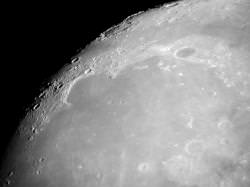 Monday, January 29 – Tonight we will return again to the lunar surface to have a look through binoculars or telescopes at another tremendous impact region.
Monday, January 29 – Tonight we will return again to the lunar surface to have a look through binoculars or telescopes at another tremendous impact region.
Continue reading “What’s Up this Week: January 29 – February 4, 2007”
First Images of the Sun from STEREO
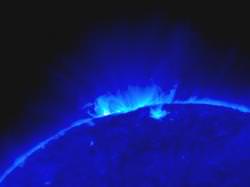 Remember the recent launch of the STEREO spacecraft? These are two identical solar observing spacecraft which will give astronomers a thrilling 3-D view of the Sun. Officially, they’re the Solar TerrEstrial RElations Observatories (STEREO… get it?), and they were lofted into orbit on October 25.
Remember the recent launch of the STEREO spacecraft? These are two identical solar observing spacecraft which will give astronomers a thrilling 3-D view of the Sun. Officially, they’re the Solar TerrEstrial RElations Observatories (STEREO… get it?), and they were lofted into orbit on October 25.
Continue reading “First Images of the Sun from STEREO”
Colliding White Dwarfs Could Create a Supergiant Star
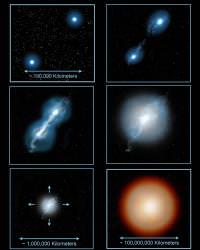 Of all the stars in our galaxy, two classes, known as hydrogen-deficient and R Coronae Borealis are extremely rare. Only a few dozen have been discovered in our entire galaxy. And unlike most of the stars out there, they have almost no hydrogen. Instead, they have abnormally high quantities of a rare isotope of oxygen.
Of all the stars in our galaxy, two classes, known as hydrogen-deficient and R Coronae Borealis are extremely rare. Only a few dozen have been discovered in our entire galaxy. And unlike most of the stars out there, they have almost no hydrogen. Instead, they have abnormally high quantities of a rare isotope of oxygen.
Continue reading “Colliding White Dwarfs Could Create a Supergiant Star”
Superstrings Could Be Detectable As They Decay
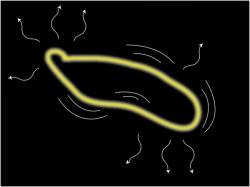 One of Einstein’s predictions for relativity is the concept of gravity waves; these are emitted whenever massive objects move. The more massive the object the stronger the gravity wave.
One of Einstein’s predictions for relativity is the concept of gravity waves; these are emitted whenever massive objects move. The more massive the object the stronger the gravity wave.
Continue reading “Superstrings Could Be Detectable As They Decay”
Hubble Sees a Hypergiant Star Nearing Death
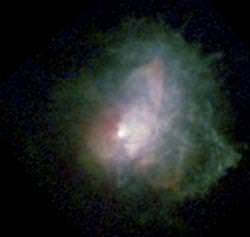 VY Canis Majoris, located about 5,000 light-years away, is no ordinary star; it’s a supergiant, containing 30 to 40 times the mass of our own Sun. And it’s so luminous it’s also considered a hypergiant, shining 500,000 times as bright as the Sun. And it’s big… really big. If this star lived in our Solar System, its surface would extend out to the orbit of Saturn.
VY Canis Majoris, located about 5,000 light-years away, is no ordinary star; it’s a supergiant, containing 30 to 40 times the mass of our own Sun. And it’s so luminous it’s also considered a hypergiant, shining 500,000 times as bright as the Sun. And it’s big… really big. If this star lived in our Solar System, its surface would extend out to the orbit of Saturn.
Continue reading “Hubble Sees a Hypergiant Star Nearing Death”
The Milky Way and the Seven Dwarfs
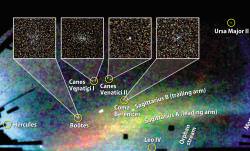 There’s no easy way to put this, our home galaxy is a killer. It’s torn up galaxies in the past, and it’s going to do it again in the future. Each galaxy we consume makes us larger. If you need evidence that this is still going on, you only need to look at the conveyor belt of dwarf galaxies orbiting the Milky Way; each of which will eventually get torn apart, its stars assimilated.
There’s no easy way to put this, our home galaxy is a killer. It’s torn up galaxies in the past, and it’s going to do it again in the future. Each galaxy we consume makes us larger. If you need evidence that this is still going on, you only need to look at the conveyor belt of dwarf galaxies orbiting the Milky Way; each of which will eventually get torn apart, its stars assimilated.
Continue reading “The Milky Way and the Seven Dwarfs”
Eagle Nebula’s Pillars Were Wiped Out Thousands of Years Ago
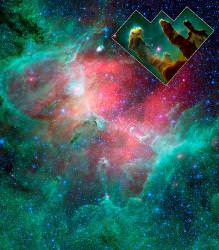 One of the most famous space photographs ever taken is the “Pillars of Creation” by Hubble, an amazing image of the Eagle nebula. But a new image from the Spitzer Space Telescope provides evidence that those towers of gas and dust might have already been wiped away.
One of the most famous space photographs ever taken is the “Pillars of Creation” by Hubble, an amazing image of the Eagle nebula. But a new image from the Spitzer Space Telescope provides evidence that those towers of gas and dust might have already been wiped away.
Continue reading “Eagle Nebula’s Pillars Were Wiped Out Thousands of Years Ago”
